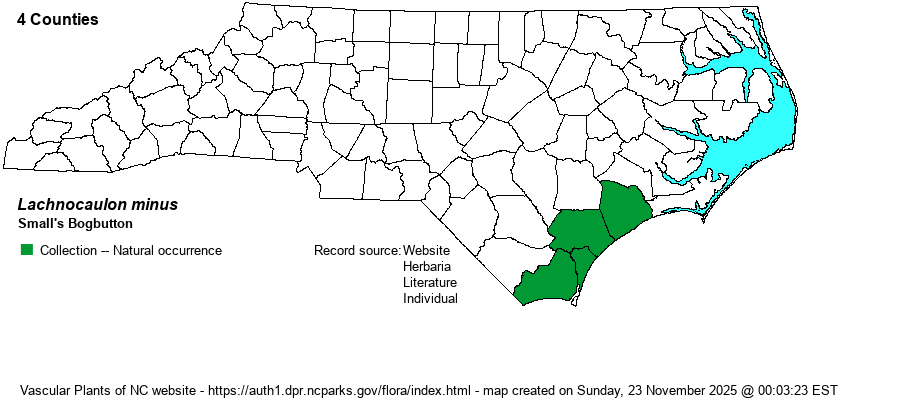| Author | (Chapman) Small | |
| Distribution | Limited to the southern outer Coastal Plain, north to Onslow County. A specimen at NCU from Bladen County was annotated in 2022 to L. beyrichianum. SERNEC specimens from Carteret, Columbus, and Bladen counties need to be checked, as these counties lie along the edge of the accepted range; a specimen from Scotland County is likely misidentified.
This is a Southern Coastal Plain species, ranging north to southeastern NC, and south to southern FL and west to AL.
| |
| Abundance | Rare, perhaps locally uncommon. The identity of many formerly "accepted" records has proven to be false: recent herbarium research showed that most NC specimens of "L. minus" actually are L. beyrichianum. The S2 rank by NCNHP seems suitable. This is a State Threatened species. | |
| Habitat | This species grows in somewhat similar habitats as other Lachnocaulon and Eriocaulon species -- damp sandy soil associated with pinelands. It grows at the margins of pineland pools and ponds, in shallow ditches, along damp roadsides that are sandy, and less so in wet pine savannas. | |
| Phenology | Flowers and fruits from May to October. | |
| Identification | This is the only rare Lachnocaulon in the state and biologists must take care in its identification. Each plant has numerous linear leaves, each only about 1.5 inches long, and a few flowering scapes that reach about 6 inches tall. The single head on each scape is globose and usually taller than wide; the other species are usually flatter and wider than tall. The head is also buffy to brownish in color, about 1/5-inch tall and 1/6-inch wide; all other Lachnocaulon and Eriocaulon species have white to grayish head color. | |
| Taxonomic Comments | Some taxonomists, now followed by iNaturalist, now name this species as Paepalanthus minor.
| |
| Other Common Name(s) | Brown Bogbutton | |
| State Rank | S2 | |
| Global Rank | G3G4 | |
| State Status | T | |
| US Status | | |
| USACE-agcp | OBL link |
| USACE-emp | OBL link |

